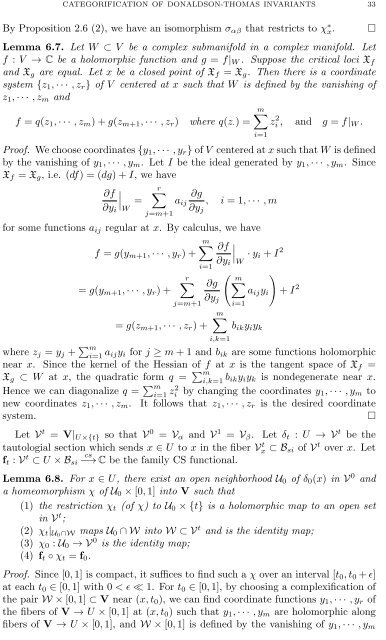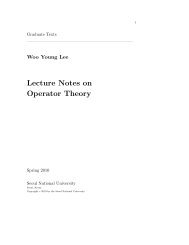Categorification of Donaldson-Thomas invariants via perverse ...
Categorification of Donaldson-Thomas invariants via perverse ...
Categorification of Donaldson-Thomas invariants via perverse ...
Create successful ePaper yourself
Turn your PDF publications into a flip-book with our unique Google optimized e-Paper software.
CATEGORIFICATION OF DONALDSON-THOMAS INVARIANTS 33By Proposition 2.6 (2), we have an isomorphism σ αβ that restricts to χ ∗ x.Lemma 6.7. Let W ⊂ V be a complex submanifold in a complex manifold. Letf : V → C be a holomorphic function and g = f| W . Suppose the critical loci X fand X g are equal. Let x be a closed point <strong>of</strong> X f = X g . Then there is a coordinatesystem {z 1 , · · · , z r } <strong>of</strong> V centered at x such that W is defined by the vanishing <strong>of</strong>z 1 , · · · , z m andm∑f = q(z 1 , · · · , z m ) + g(z m+1 , · · · , z r ) where q(z·) = zi 2 , and g = f| W .Pro<strong>of</strong>. We choose coordinates {y 1 , · · · , y r } <strong>of</strong> V centered at x such that W is definedby the vanishing <strong>of</strong> y 1 , · · · , y m . Let I be the ideal generated by y 1 , · · · , y m . SinceX f = X g , i.e. (df) = (dg) + I, we have∂f∂y i∣ ∣∣W=r∑j=m+1a ij∂g∂y j,i=1i = 1, · · · , mfor some functions a ij regular at x. By calculus, we havem∑ ∂f∣ ∣∣Wf = g(y m+1 , · · · , y r ) + · y i + I 2∂y i= g(y m+1 , · · · , y r ) +r∑j=m+1i=1= g(z m+1 , · · · , z r ) +( m)∂g ∑a ij y i + I 2∂y ji=1m∑b ik y i y ki,k=1where z j = y j + ∑ mi=1 a ijy i for j ≥ m + 1 and b ik are some functions holomorphicnear x. Since the kernel <strong>of</strong> the Hessian <strong>of</strong> f at x is the tangent space <strong>of</strong> X f =X g ⊂ W at x, the quadratic form q = ∑ mi,k=1 b iky i y k is nondegenerate near x.Hence we can diagonalize q = ∑ mi=1 z2 i by changing the coordinates y 1 , · · · , y m tonew coordinates z 1 , · · · , z m . It follows that z 1 , · · · , z r is the desired coordinatesystem.□Let V t = V| U×{t} so that V 0 = V α and V 1 = V β . Let δ t : U → V t be thetautologial section which sends x ∈ U to x in the fiber Vx t ⊂ B si <strong>of</strong> V t over x. Letf t : V t cs⊂ U × B si −→ C be the family CS functional.Lemma 6.8. For x ∈ U, there exist an open neighborhood U 0 <strong>of</strong> δ 0 (x) in V 0 anda homeomorphism χ <strong>of</strong> U 0 × [0, 1] into V such that(1) the restriction χ t (<strong>of</strong> χ) to U 0 × {t} is a holomorphic map to an open setin V t ;(2) χ t | U0∩W maps U 0 ∩ W into W ⊂ V t and is the identity map;(3) χ 0 : U 0 → V 0 is the identity map;(4) f t ◦ χ t = f 0 .Pro<strong>of</strong>. Since [0, 1] is compact, it suffices to find such a χ over an interval [t 0 , t 0 + ɛ]at each t 0 ∈ [0, 1] with 0 < ɛ ≪ 1. For t 0 ∈ [0, 1], by choosing a complexification <strong>of</strong>the pair W × [0, 1] ⊂ V near (x, t 0 ), we can find coordinate functions y 1 , · · · , y r <strong>of</strong>the fibers <strong>of</strong> V → U × [0, 1] at (x, t 0 ) such that y 1 , · · · , y m are holomorphic alongfibers <strong>of</strong> V → U × [0, 1], and W × [0, 1] is defined by the vanishing <strong>of</strong> y 1 , · · · , y m□













